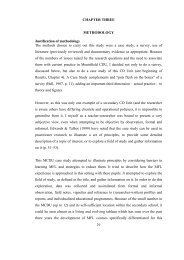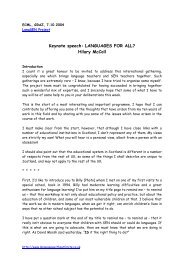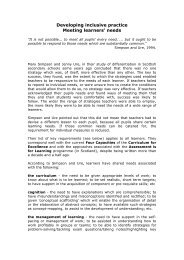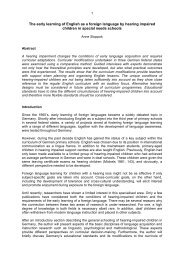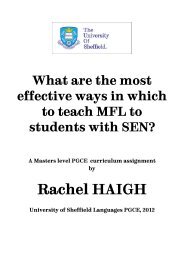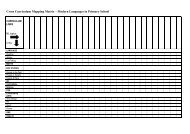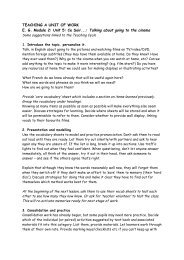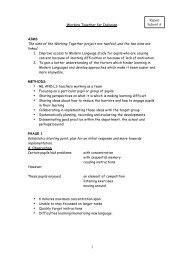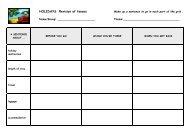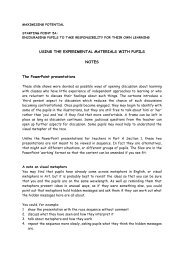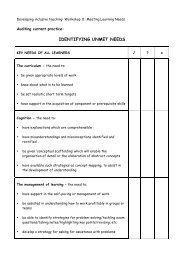Chapter 5: Planning Modern Foreign Languages lessons
Chapter 5: Planning Modern Foreign Languages lessons
Chapter 5: Planning Modern Foreign Languages lessons
Create successful ePaper yourself
Turn your PDF publications into a flip-book with our unique Google optimized e-Paper software.
LANGUAGE AND THE CURRICULUM: PRACTITIONER RESEARCH IN PLANNING DIFFERENTIATION<br />
Deirdre Martin and Carol Miller<br />
David Fulton Publishers (1999)<br />
Reproduced by kind permission of Taylor and Francis Publishers<br />
<strong>Chapter</strong> 5: <strong>Planning</strong> <strong>Modern</strong> <strong>Foreign</strong> <strong>Languages</strong> <strong>lessons</strong><br />
Introduction<br />
This chapter looks at aspects of teaching French in a secondary special school. Until the mid 1980s,<br />
students in special schools had rather limited access to a curriculum in modern foreign languages (MFL). At<br />
best, some elements for example, of French language and culture, were built into a humanities module. In<br />
many cases, they were not taught at all. However, since September 1993, it has been statutory to teach a<br />
foreign language to all secondary-age students in England and Wales. The document Modem <strong>Foreign</strong><br />
<strong>Languages</strong> for Ages 11 to 16 (Department of Education and Science/Welsh Office 1990) stated that all<br />
pupils, including those with special educational needs, should have the opportunity to experience a modern<br />
foreign language. Many teachers in mainstream and special schools expressed serious concern about the<br />
value and purpose of MFL teaching, especially to children who had profound or severe learning difficulties.<br />
Doubts, scepticism and perhaps anxiety were expressed by teachers who sometimes were concerned about<br />
whether children who were acquiring their first language only slowly could be expected to learn other<br />
languages (Veliante 1995). On the other hand, there were many MFL teachers who saw this change as a<br />
welcome and natural progression from the first introduction of the National Curriculum.<br />
In the past, language courses may have been predominantly linked with examination requirements<br />
and pupils with special educational needs were often excluded. Ability in foreign languages was sometimes<br />
assumed to be demonstrated through vocabulary lists and grammatically correct, mainly written,<br />
structures. However, the document <strong>Modern</strong> <strong>Foreign</strong> <strong>Languages</strong> in the National Curriculum (Department for<br />
Education and Employment 1995d) suggests that the revised National Curriculum provides teachers with<br />
much greater flexibility to respond to the needs of pupils with identified special needs. However,<br />
considerable changes in thinking were necessary as teachers began to adapt and differentiate the MFL<br />
curriculum to meet the needs of all secondary-age students.<br />
Why teach modern foreign languages?<br />
The teaching of modern foreign languages raises a number of issues and, with particular reference to pupils<br />
with special educational needs, it is worth reviewing the aims of such teaching. As with the English<br />
curriculum, modern foreign language teaching has four broad Attainment Targets: listening, speaking,<br />
reading and writing. Activities would also have the following aims:<br />
• to develop the ability to use language effectively for purposes of practical communication;<br />
• to form a sound base of the skills, language and attitudes required for further study, work and<br />
leisure;<br />
• to offer insights into the culture and civilisation of the countries where the language is spoken;<br />
• to develop an awareness of the nature of language and language learning;<br />
• to provide enjoyment and intellectual stimulation;<br />
• to encourage positive attitudes to foreign languages and a sympathetic approach to other cultures<br />
and civilisations;<br />
• to promote learning of skills of more general application (e.g. analysis, memorising, drawing of<br />
inferences);<br />
• to develop pupils' understanding of themselves and their own culture.<br />
(Department of Education and Science/Welsh Office 1990)
There are clear links between the learning of a first language and a 'foreign' language. The learning<br />
of foreign languages is thus an extension of children's learning of language and, as Lee (1991) observes, it<br />
engages intellectual, social, cultural and affective aspects of learning. In learning modern foreign languages,<br />
students become aware of the nature of language by experiencing, or by consciously thinking about, new<br />
language that is different from their own. It has the potential to enhance their awareness of many aspects<br />
of language and to enable pupils to manipulate and play with language in ways which may not be possible in<br />
their own, too familiar, language. The learning of a foreign language can help pupils to think differently<br />
about language and to talk about language. There may be opportunities to listen to sounds and rhythms<br />
that are different from those in their first language and to ask questions such as 'How do you say ... in<br />
French?' 'What's the French for ... ?'. This so-called metalinguistic awareness, or the ability to think and talk<br />
about language, is considered to be an important aspect of development and in particular to assist in the<br />
development of literacy. It has the potential to enable a person to take greater control of language. This<br />
will be an important target for all children but will have particular significance for children with difficulties in<br />
language and communication.<br />
A further, important feature of foreign language learning is the opportunity it provides for students<br />
to succeed. As a new subject for many students going into secondary school, they are unlikely to have<br />
experienced failure or poor achievement in a foreign language and there is therefore potential for raising<br />
pupils' self-esteem. Perhaps this is the primary aim of MFL teachers and, if self-esteem is linked with overall<br />
social and communication development, there can be no doubts about the rationale for this area of the<br />
curriculum.<br />
<strong>Planning</strong> for effective MFL teaching<br />
The planning of foreign language teaching will, clearly, require knowledge of the particular language. Where<br />
there are pupils with special educational needs, it will also be important to understand their specific<br />
strengths and needs. The linking of these two areas of teachers' knowledge and skill may be especially<br />
challenging and the support of colleagues can be particularly helpful. At times, it can be difficult for an<br />
individual practitioner to reflect critically and objectively on their own work. The reviewing process is<br />
enhanced if information can be discussed with a colleague or critical friend. In collaboration, professionals<br />
can contribute and gain new insights and as a result new plans can be devised and carried out. In many<br />
cases, collaboration between the specialist language teachers and the special educational needs<br />
coordinator, or another teacher or assistant who supports pupils with special needs, will provide the best<br />
opportunities for successful planning. Where there are children with particular language and communication<br />
difficulties, a speech and language therapist may also be involved. Successful collaboration inevitably takes<br />
time, to discuss and plan together and to ensure that everyone is able to contribute their views. In a study<br />
of schools which were introducing modern foreign languages to pupils with special educational needs it was<br />
recommended that teachers should be able to spend non-contact time together (Lee 1991). Without this,<br />
it was suggested that it would be difficult for colleagues to work in equal partnership with complementary<br />
skills and knowledge. Practitioners will have to consider carefully how this can be made possible and will<br />
need to enlist senior colleagues who can support their collaborative activities.<br />
The planning<br />
The plan and description of French teaching sessions which follow relate to a Year 10 class with 12<br />
students, two of whom are described as having speech and language difficulties. The focus of teaching and<br />
learning is on realistic, active and practical communication, with greater emphasis on listening and speaking<br />
in the foreign language. The plan and subsequently the lesson, resulted from a group effort by staff. Their<br />
wish to critically analyse and evaluate their activities lead to a changed, improved lesson plan based on an<br />
adapted format. This forms part of a cycle where reflection on practice aims to continuously improve the<br />
quality of students' learning.<br />
Assessment of students' learning and of teachers' teaching is an important component of the cycle.<br />
Teacher assessment needs to be preceded by careful planning followed by subsequent management of<br />
teaching stages, bearing in mind the students' individual needs. Assessment is effective when it leads to<br />
reflection on how and why things happened and on future action to improve existing teaching methods and
students' learning. During this process of reviewing existing practice, clear, appropriate learning goals are<br />
established which form key elements in the planning of the next teaching sessions.<br />
In working to include all pupils in classroom teaching and learning, teachers will face pupils in their<br />
class whose individual needs may be different from those of the majority of the class. Tried and tested<br />
teaching strategies may not have the usual effect. An action research approach can help in developing the<br />
reflective practice which can lead to greater understanding of pupils' individual needs.<br />
This is particularly important when planning <strong>lessons</strong> for children with speech and language<br />
difficulties, who may not be able to pay attention or understand in the same way as other pupils. They may<br />
not be able to participate verbally to the same extent in <strong>lessons</strong>, or their contributions may be less<br />
intelligible. Class teachers of children with speech and language difficulties should expect to have regular<br />
meetings with learning support assistants (LSAs), parents, educational psychologists and speech and<br />
language therapists. All of these provide valuable information which can contribute to revised lesson plans<br />
of subsequent teaching sessions.<br />
In the plans presented below, K and S are described as having speech and language difficulties. S<br />
had joined the class less than a week before recorded planning began. He had transferred from another<br />
secondary special school where MFL were not taught.<br />
Notes made immediately after the session help in a subsequent evaluation and lead to changes<br />
which will be described. During the review, positive as well as negative aspects of teaching are considered.<br />
New targets are being set. A further MFL teaching session is planned and carried out for the same year<br />
group using the new lesson plan. The action research spiral has then completed one cycle and is ready to<br />
move forwards.<br />
<strong>Planning</strong> the first lesson<br />
The main aim of the MFL department is for students to enjoy the language and maintain their enthusiasm<br />
through focus on active communication, keeping the written element to a minimum. This enables students<br />
to experience and celebrate their own achievement, however small that may be. A learner-centred,<br />
communicative approach is used. The aim is to motivate students to want to learn the target language so<br />
that they will use it for their own purpose of communication.<br />
Students in Years 10 and 11 at the school follow a French course consisting of self-contained<br />
modules lasting approximately four <strong>lessons</strong> (Bates et al. 1996). They are taught once a week for 40<br />
minutes. The modules require students to have minimal previous knowledge of the foreign language. This is<br />
particularly appropriate, as many of the students experience memory difficulties. 'Long-term' aims are<br />
based on four-lesson blocks.<br />
Long-term aims<br />
Students to understand and practise new 'language of weather' module, in order to be able to take part in<br />
role play scenes.<br />
Students to develop listening, speaking, reading and writing skills in French through focus on new 'language<br />
of weather' module (MFL National Curriculum Attainment Target (AT)1: Listening, AT 2: Speaking, AT 3:<br />
Reading and AT 4: Writing).<br />
Learning tasks<br />
1. To introduce new module, making clear aims and outcome of the module.<br />
2. To introduce new weather vocabulary.<br />
3. To develop listening skills: to show understanding of short French phrases placed in context; to<br />
respond to a clear model of standard French language spoken at reduced speed.<br />
4. To develop speaking skills: to give short, simple responses in French; to describe pictures and<br />
objects with single French words using approximate pronunciation which is understandable by a<br />
sympathetic native speaker.<br />
5. To develop reading skills: to show understanding of short familiar phrases presented in clear print;<br />
to match sound to print by reading aloud individual familiar words.<br />
6. To prepare for learning homework of new phrases.
7. To develop social communication skills: to pay attention to speaker; to improve concentration; to<br />
show appropriate eye contact; to use appropriate turn-taking skills; to accept rules of a game; to<br />
show respect for each other.<br />
Resources<br />
The planning of any teaching and learning will need to take account of the effective use of resources,<br />
including the people available. In this case they were:<br />
Learning Support Assistant<br />
video<br />
overhead projector (OHP)<br />
tape recorder<br />
flash cards<br />
whiteboard<br />
self-adhesive weather labels<br />
worksheet<br />
homework sheet.<br />
Lesson outline<br />
The outline of the lesson takes into account a range of objectives related to paying attention, listening,<br />
speaking and reading.<br />
1. To introduce weather module, students watch a two-minute video of weather forecast; brief<br />
discussion, comparisons with own language, followed by demonstration of aims of module; recap<br />
principles of role plays.<br />
2. To develop listening skills through presentation of weather vocabulary, show pictures on OHP, play<br />
tape recording of brief weather expressions, to be repeated at slower speed by teacher; match with<br />
pictures; similar matching activity, this time with coloured flash cards which, once core vocabulary is<br />
understood by most students, is turned into a team game; constantly attending to and stimulating<br />
students' attention skills as part of improving their listening skills through verbal as well as nonverbal<br />
reinforcers.<br />
3. To develop speaking skills: hold up flash cards and say corresponding weather expression, students<br />
to repeat as a group, followed by volunteering individuals; for this, differentiation is by outcome,<br />
students either say initial sound, core word or the complete weather expression; this is turned into a<br />
guessing game where teacher initially whispers the new language, then just mouths it; next,<br />
students are not shown the picture on the flash card and have to guess it using taught French<br />
weather expressions; teacher to respond only with 'oui' or 'non'; if positive, student keeps the flash<br />
card; winner is the one with most flash cards.<br />
4. To develop reading skills and prepare for learning homework, write and repeat verbally core words of<br />
weather expressions in large print on whiteboard; to match with self-adhesive weather labels;<br />
pointing at print and picture, hand out worksheet and read aloud together with class focusing on<br />
initial sounds of words, which are underlined; students have to fill in the missing words in partprinted<br />
weather expressions and draw the matching weather symbol; give out homework sheet<br />
which shows the complete weather phrases, used in previous listening and speaking activities, as<br />
well as the same weather symbols as the ones used on the OHP and the self-adhesive labels;<br />
students copy the core words from the board in between the matching text and picture;<br />
differentiated learning homework consists of either learning the copied core words or the whole<br />
weather expressions.<br />
Although not all pupils will perform in all skills, it is useful to identify general targets which will apply to all<br />
students. Deane (1992) suggests that minimum attainable targets are set. In this case they were:<br />
to be able to understand some of the core language;<br />
to be able to express verbally some of the core language;<br />
to match some visual stimuli with some of the printed core language;<br />
to copy some of the printed core language from the whiteboard.
With these general targets in mind, individual targets are also set so that each pupil will have a minimum to<br />
be attained. Individual targets for K and S were discussed with the LSA who would support them:<br />
K – To note down initial letters of words from whiteboard, LSA to help with written work.<br />
S – To develop expressive language skills by attempting initial sound of core expressions.<br />
Using all of these considerations a plan was drawn up for the first of four teaching sessions (see<br />
Figure 5.1 at end of chapter).<br />
Evaluation of MFL lesson<br />
Once the first lesson had taken place, the plan was discussed with a teacher colleague and the LSA in order<br />
to identify areas of strength and weakness. Using this first lesson as a basis, the aim was for future lesson<br />
plans to improve on this and for subsequent <strong>lessons</strong> to be more effective. Generally, it was considered that<br />
the plan formed a good base. However, it was noted that there was no place for some essential information<br />
in the existing lesson plan format. There was no mention of 'key vocabulary' or 'individual targets'.<br />
Communication between colleagues who were involved in the <strong>lessons</strong> was therefore inadequate. The plan<br />
was consequently developed and rewritten, based on the first lesson taught. (See Figure 5.2).<br />
Some information, for example students' individual targets, needed to be more specific. Student K,<br />
after watching the introductory video, found it hard to focus on the discussion and perseverated loudly on<br />
presenters of British television weather forecasts. He gave detailed, but irrelevant information about<br />
Michael Fish and Susanne Charlton (television forecasters). lt took a lengthy, quiet, one-to-one conversation<br />
with K and the prospect of obtaining the full merit mark at the end of the lesson, to bring him back to the<br />
task. Throughout the lesson, K displayed some repetitive behaviours such as hand-flapping and biting his<br />
index finger repeatedly. These behaviours were not mentioned in his individual targets, even though they<br />
occurred frequently when he became excited during games. They needed to be addressed as part of the<br />
overall plan to develop improved communication skills.<br />
As colleagues discussed the experience of the lesson, ideas and comments were pooled, highlighting<br />
aspects which needed improvement. It was suggested that the class had been faced with too many<br />
weather expressions in one lesson. Only one out of 12 students remembered the English meaning of 'il fait<br />
du brouillard' (it is foggy) and it would possibly have been more beneficial to use fewer phrases. Instead,<br />
there could be more repetition or consolidation through a wider variety of activities.<br />
The biggest challenge was presented by S, who had only recently joined the school and took part in<br />
his first ever French lesson. The teacher knew he had some difficulties expressing himself, but was unaware<br />
of the extent of the problem and the direct effect it would have on his spoken communication. S tried to<br />
produce initial sounds of words, for example, 's' for 'sun' which he accompanied with sign language. Even<br />
though he obviously wanted to participate, his attempts were largely unintelligible to everyone. In addition,<br />
he could not read words printed on the whiteboard or on worksheets.<br />
A meeting between the speech and language therapist, LSA and teacher was arranged prior to the<br />
next French lesson. It became evident that some of the records from his last school had not been passed<br />
on. The therapist, who had known him in his previous school, was able to provide important information and<br />
to suggest strategies. S had a visual impairment which required print to be enlarged and placed on a slightly<br />
tilted board on top of his desk. S's difficulties in producing speech sounds were partly caused by a<br />
condition which severely disrupted the motor control of his speech. When he attempted to produce an<br />
initial sound, he used either the British finger spelling alphabet or a symbol from Paget Gorman Signed<br />
Speech which he was taught at his previous school. This seemed to offer a useful way to enhance his<br />
communication. The principles of the finger spelling were explained by the speech and language therapist<br />
and guidelines were handed out to all colleagues.<br />
Colleagues' observations suggested that the range of activities and diversity of strategies were<br />
successful in the first lesson. These had helped the students to achieve their general targets. Focusing on<br />
initial letter sounds in listening and reading activities appeared to have helped the students to memorise<br />
new language. The games had clearly motivated the students, who could easily have continued with those<br />
until the end of the lesson.
The observed highlights and weaknesses of the lesson were summarised.<br />
Strengths<br />
1. The video presented a stimulating start to the module; it encouraged group discussion.<br />
2. The variety of activities helped to maintain the students' attention. Their enthusiasm lasted for<br />
most of the lesson. They responded with positive feedback at the end of the lesson: 'That lesson<br />
went quick, wicked!'<br />
3. Focus on initial letter sounds was successful in both listening and reading activities.<br />
4. The games were a great success.<br />
5. All general targets were met.<br />
Weaknesses<br />
1. The planned role play did not present an appropriate long-term goal; it was too vague and artificial.<br />
2. Too much new language was presented at once.<br />
3. The pace of presentation was too fast.<br />
4. Not all students' needs were taken into account; not all of their individual targets were specified, for<br />
example, some quiet students could have been encouraged to contribute more.<br />
5. The literacy worksheet was too demanding; the majority of students seemed tired and experienced<br />
difficulties.<br />
6. Student K did not stay focused and showed signs of repetitive behaviours; individual targets were<br />
too vague and should have been more clearly defined, for example, for K to stay focused for a<br />
specified amount of time.<br />
7. S could not read presented print; he had major problems expressing himself due to unforeseen,<br />
severe difficulties with speech sounds.<br />
Revised planning, and effects of subsequent MFL lesson<br />
The planning of any <strong>lessons</strong> needs to take account of the individual strengths and needs of the children and<br />
an understanding of the way each child responds will be important. Where children have speech and<br />
language difficulties, account will be taken of the specific nature of their difficulty. To be able to reflect on<br />
existing practice and adapt strategies according to the students' needs is central to achieving effective<br />
teaching and is, of course, the essence of differentiation.<br />
The development of suitable teaching and learning activities must always be open to change in the<br />
light of experience and new information. The employment of a cycle of planning, acting and reflecting can<br />
lead to change and improvement in existing practice. In this case, the cycle suggests how a further MFL<br />
lesson which followed the revised lesson plan, could result in more effective teaching and improve students'<br />
learning, as it was based on insights and conclusions drawn from the evaluation of a lesson plan and the<br />
experience of teaching the lesson.<br />
A new plan was drawn up, using the experience of the previous <strong>lessons</strong>, for the first of four more<br />
teaching sessions. The title of the new module was 'At the Post Office' (see Figure 5.3).<br />
Generally, most of the methods and approaches applied in the first lesson were appropriate. The<br />
choice and management of activities were also considered to be suitable. They could therefore be adopted<br />
again in subsequent <strong>lessons</strong>. They had helped to achieve the main aims which were to make MFL learning an<br />
enjoyable experience, to foster active communication in the foreign language and, as a consequence it was<br />
hoped that students' self-esteem would be raised.<br />
Discussions with colleagues and further reviews had helped to identify areas which could be<br />
improved. The focus had shifted from a general MFL lesson plan to one which took account of the specific<br />
needs of individual students, including those with speech and language difficulties.<br />
The selection and amount of new vocabulary needed reviewing. Many children with speech and<br />
language difficulties do not learn language easily or spontaneously and possibly, some do not learn language<br />
in the same way as their peers. The introduction of new vocabulary has to be carefully planned.<br />
Consideration needs to be given to the number of new words and phrases. These may have to be repeated<br />
regularly and in many different ways. Different pupils will learn in different ways, that is, they have different<br />
'learning styles'. For example, some may be helped by visual material and others by auditory stimuli. Some
learn better individually, while others respond to questions and discussion in groups. It is important, when<br />
working with a group, to utilise a range of approaches in order to meet the preferred learning style of all<br />
pupils. Conversely, when working with individuals, it is important that they experience a variety of<br />
approaches in order to develop a wider repertoire of learning strategies (Kyriacou et al. 1996).<br />
In the new plan for At the Post Office, fewer words and phrases were introduced. Students were<br />
therefore able to memorise almost all of the new language, even though one of them required some visual<br />
prompting (holding up a stamp when 'un timbre' was the required response). The students' memory of the<br />
newly-taught core words was assessed during listening activities in both <strong>lessons</strong>. Comparison of the two<br />
charts (Figures 5.4 and 5.5) show that students had a higher success rate in the second lesson (the 'post<br />
office' lesson) compared with those of the first (the 'weather' lesson).<br />
Additionally, the new vocabulary was carefully selected for practical reasons. It could easily be<br />
connected to create a range of simple, realistic role play situations at the post office. All students,<br />
including the shy ones, had an opportunity to practise and adapt newly-learned language in pairs. They<br />
enjoyed this social learning activity, especially as real props, such as stamps, postcards and envelopes were<br />
used. It was anticipated however, that student K might be distracted by these props. He was therefore<br />
placed with a role play partner close to a support assistant. She occasionally redirected him back to the<br />
task as he tried to divert the conversation to his brother's stamp collection. However, when compared with<br />
the previous lesson, this did not interfere with the continuity and progression of the class as a whole and<br />
his diversions did not last as long.<br />
Target setting for individual students had to be further improved. Clearly defined, realistic, mostly<br />
short-term targets were set for both students K and S. Some of these had been previously discussed with<br />
teacher, students, parents and LSA and recorded on the students' Individual Education Programmes. It was<br />
agreed that a consistent adult approach was important.<br />
Student K needed support in remaining on task. His target, which was discussed with him, was to<br />
stay focused for a minimum of, initially, one minute, when addressed personally. On successful completion,<br />
this would be gradually increased. Apart from digressing on to his brother's stamps, he did succeed in<br />
meeting this specific target. His hand-flapping and finger-biting were also addressed. In order to raise his<br />
awareness of these behaviours, they were discussed with him during lunchtime. He agreed to follow a<br />
staged plan which should help him first to reduce hand-flapping, so that his behaviour would become more<br />
socially acceptable. Figure 5.6 shows the plan, which was successful up to stage 4.<br />
Student S had difficulties expressing himself verbally and communicating with his peers. As a result<br />
of a meeting between the teacher, LSA and S, it was agreed, at the boy's request, that he should use the<br />
British Finger Spelling Alphabet for initial letters in <strong>lessons</strong> and to attempt the initial letter sounds. This<br />
worked with limited success as his communication was restricted to single words. S stated that he<br />
preferred not to use Paget Gorman Signed Speech. Possibly at the age of fifteen he did not want to be seen<br />
to be very different from his friends. Communication with his peers remained difficult, even though it slowly<br />
improved as other students began to learn finger spelling, displayed near the whiteboard and his desk.<br />
Children with speech and language difficulties may experience additional problems. Written language<br />
is closely linked with spoken language and many children with speech and language difficulties also<br />
experience problems with literacy. They may also experience difficulties with their fine and/or gross motor<br />
control. K's letter formation was slow. His writing appeared large, unconnected and sometimes reversed. It<br />
seemed uncoordinated and was difficult to read. He held pens with a tight grip. However, as K's spelling and<br />
general reading ability were now in line with that of the rest of his peers, he was given access to a<br />
wordprocessing package on the computer. This greatly assisted and improved the presentation of his<br />
written work.<br />
Additionally, K had difficulties with language meaning. He often made literal interpretations which<br />
suggested a difficulty in understanding that words can have more than one meaning. This sometimes made<br />
him appear bizarre or even rude. When the teacher explained to the students 'The core words are the ones<br />
in bold print', K responded: 'That's not right. How can words be bold. People are bold, aren't they?' The<br />
LSA managed to explain that the core words were in a darker, slightly bigger print. The teacher made an<br />
effort in the second lesson to avoid or to explain ambiguous language. Adults' language in class is an<br />
important element of differentiation. Close observation and comment by colleagues can be used to draw<br />
attention to style of presentation of information so that misunderstandings can be reduced. Forward<br />
planning will also help in identifying potential pitfalls so that explanations can be given and pupils can be<br />
helped to understand new language.
For student S, texts in all subsequent <strong>lessons</strong> were placed on a board, at an angle on top of his<br />
desk. They were enlarged and presented in clear print which contained essential, unambiguous information.<br />
This gave S the opportunity to respond more easily to written language.<br />
Once the second lesson had been taught, the teacher, as well as the students, experienced a<br />
greater sense of achievement compared with the previous lesson. However, in reflecting on aspects of the<br />
second lesson, further areas for development could still be identified. It was noted that individual target<br />
setting could be extended and that the LSA could have been involved more effectively.<br />
The spirals of planning, acting and reviewing can go on and on and can continue to influence change<br />
and further improvement. For any teaching it is impossible to foresee every eventuality. Each lesson will<br />
contain an unpredictable element. Changes can occur at many different levels. An approach which has been<br />
a real success for many classes, for some reason may not work. These are minor setbacks and should not<br />
divert from the main goals.<br />
In addition to identifying pupils' needs, the reflective cycle can also raise issues for further staff<br />
development. For example, where aspects of further fine-tuning in lesson plans and activities are identified,<br />
staff may wish to consider the implications for their own professional learning. Does it mean that some<br />
further reading could be useful? Does it mean that discussion with a more experienced colleague, perhaps<br />
an 'outsider', could be useful? In the cycles described in this chapter, one of the conclusions was that some<br />
in-service training could be helpful.<br />
Conclusion<br />
The MFL department's main purpose was to boost students' self-confidence by giving them the opportunity<br />
to experience and to celebrate their own achievement. Pupils may easily dismiss their chances of success in<br />
learning a MFL, particularly when the criteria for success seem to mirror those on which they have been<br />
judged to have failed elsewhere, that is, in language. In guidance on modern foreign languages (National<br />
Curriculum Council 1992a), it is recommended that pupils should be able to take risks in a secure<br />
environment and experience success. A secure environment for pupils with special educational needs should<br />
certainly be attainable for the planning and teaching of MFL. It has the potential to offer a fresh start to<br />
pupils who have experienced failure in their primary education, perhaps particularly those with speech and<br />
language difficulties. Students who experience literacy problems may find that they manage reading and<br />
writing activities in MFL. Students who find it difficult to talk in front of the class, may develop greater<br />
confidence through practice in role plays.<br />
The SCAA (1997) publication, Use of Language: a common approach, recommends taking account<br />
of the needs of all pupils, including the more able, those with special educational needs and pupils for whom<br />
English is a second language. The experiences described in this chapter suggest that this is possible in the<br />
case of foreign language teaching.<br />
NOTE<br />
Figures 5.1 to 5.6 can be found in separate PDF files on the website <br />
References<br />
Bates, V., Coyle, D., Laverick, C. (1996) The Special Schools Dimension: A distance learning resource for teachers of<br />
MFL in Special Schools. London: Centre for Information on Language Teaching and Research.<br />
Deane, M. (1992) ‘Teaching MFL to pupils with special needs? With pleasure!’, Language Learning Journal 6, 43-47.<br />
Department for Education and Employment(1995d) <strong>Modern</strong> <strong>Foreign</strong> <strong>Languages</strong> in the national Curriculum. London:<br />
HMSO.<br />
Department of Education and Science/Welsh Office (1990) <strong>Modern</strong> <strong>Foreign</strong> <strong>Languages</strong> for Ages 11 to 16. London:<br />
HMSO.<br />
Kyriacou, C. Benmansour, N., Low, G. (1996) ‘Pupil learning styles and foreign language learning’. Language Learning<br />
Journal 13, 22-24.<br />
Lee, B. (1991) Extending opportunities: modern foreign languages for pupils with special educational needs. Slough:<br />
National Foundation for Educational Research.<br />
National Curriculum Council (1992a) Non-Statutory Guidance: <strong>Modern</strong> <strong>Foreign</strong> <strong>Languages</strong>. London: HMSO.<br />
School Curriculum and Assessment Authority (1997) Use of Language: a common approach. London: SCAA.<br />
Veliante, N. (1995) ‘Teaching languages to pupils with special educational needs: success with pupils with Asperger’s<br />
Syndrome’, in <strong>Languages</strong> and Special Educational Needs. London: Centre for information on Language Teaching and<br />
Research.



